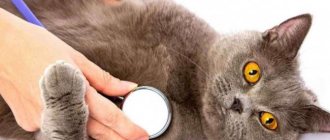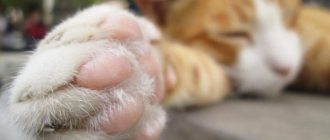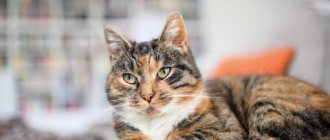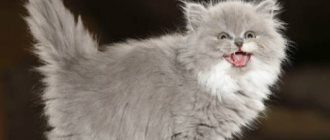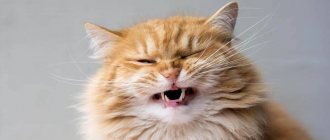The cat sniffles: reasons
The causes of cat sniffing are divided into natural and pathological.
Natural ones include:
- increased physical activity - the number of inhalations and exhalations of animals is directly dependent on the degree of load on the body (a breathless animal may make uncharacteristic sounds, including sniffling);
- excitement, fear, anger, overexcitement - excited cats breathe frequently and noisily, which can occasionally be accompanied by wheezing (the described symptoms disappear immediately after the source of stress is removed);
- pregnancy, feeding kittens, sexual arousal;
- overheating (in this case, the pet breathes through its mouth, making a whistle and trying to sit on the floor in the coolest place);
- occasional sneezing.
Pathological causes include:
- swelling of the larynx due to swallowing inedible objects or allergies to food;
- asthma (in this case, the pet suffers from attacks of suffocation, accompanied by coughing and appearing both day and night);
- kidney stones (the disease is accompanied by hoarse breathing);
- helminthiases;
- diseases of the ENT organs, for example, bronchitis;
- heart failure (the animal’s mucous membranes become bluish, it coughs and wheezes);
- viral infections (in addition to wheezing, the pet may develop discharge from the nose and eyes, increase body temperature, and lose appetite);
- obesity (excess weight increases the load on the heart, which, in turn, is accompanied by shortness of breath and snoring);
- mechanical damage to the chest (in this case, the cat begins to stick out its tongue, its breathing becomes shallow).
Be sure to read:
Why does a kitten sneeze: the main reasons, what to do, how to treat, when to contact a veterinarian
The nature of the sounds produced can indicate the location of the problem area:
- wet wheezing indicates accumulation of mucus in the respiratory tract;
- dry wheezing indicates swelling of the bronchi and larynx;
- crackling hints at the pathology of the pulmonary alveoli;
- A whistle indicates swelling of the airways.
Do cats snore?
For some reason, many owners find it unimaginable that a cat can snore in its sleep. Many ponytail owners are actively searching for information, and veterinary forums are exploding with heated discussions like “My cat snores, is this normal?” A cat is a living creature with a respiratory system that is similar to that of a human. Do you think it is normal for a person to snore? Many people do not pay attention to this, although if a person suffering from snoring undergoes an examination, the cause can be found out. The situation is similar with cats; if a pet has been sleeping quietly for 5 years and suddenly turns into a rumbling, grunting and sniffling ball of fur - this is not normal.
Due to physiological characteristics, brachycephalic cats (short, depressed, flattened nose) snore and sniffle in their sleep. Congenital deformation, and specifically, narrow nasal passages lead to difficulty breathing. It should be noted that brachycephals suffer more from colds and diseases of the respiratory system, so if snoring turns into suffocation, the pet should be shown to a veterinarian.
Just like people, cats have dreams in which the pet may be hunting, running or fighting. If a cat snores and grunts, actively clenches and unclenches its fingers, wags its tail or moves its ears, most likely the reason is an uncomfortable body position, a tight chest, or worries about “what is happening.” Most often, snoring attacks due to dreams do not recur frequently. Violent behavior during sleep indicates nervous overexcitation, the cause of which is any kind of stress.
Periodic vibrating rumbling, reminiscent of snoring, can also be a completely natural phenomenon. A healthy cat will not snore while napping in a noisy room, however, if the animal sleeps in a quiet place and feels completely calm, purring may occur. This is due to the relaxation of the chest muscles, which does not occur until the pet is sure of safety.
Important! Any breathing disorder is a reason for a veterinary examination, even if the case of suffocation was isolated.
The cat sniffles: what to do
If you hear your cat's sniffling only occasionally, there is no need to worry. However, if the animal constantly makes unusual sounds or breathes through its mouth, you should immediately consult a veterinarian.
The diagnosis can be made based on analysis of the following information:
- the age of the animal and the conditions of its detention;
- body weight and its compliance with the norm for a given breed;
- duration of snoring;
- the presence (absence) of other extraneous sounds other than sniffling;
- shade of mucous membranes;
- presence of injuries;
- changes in behavioral characteristics;
- presence (absence) of symptoms inherent in certain diseases;
- laboratory test results.
Once the diagnosis is made, the veterinarian will prescribe treatment.
Attention! It is not recommended to treat a wheezing animal before going to a veterinary clinic. This can lead to a deterioration in the pet's condition and reduce the prognosis for recovery.
Respiratory diseases of cats - diagnosis and treatment
For chronic diseases of the upper respiratory tract, the examination includes x-rays of the skull. Also, if possible, a computed tomography scan of the skull. All this is done in combination with a thorough examination of the oral cavity, rhinoscopy and laryngoscopy.
Cats with suspected pleural effusion undergo chest x-ray and ultrasound with possible thoracentesis. Assessment of pleural fluid is used to differentiate types of effusions.
For pathologies of the lower respiratory tract, a good quality radiograph of the chest cavity is important. Lateral and ventrodorsal (or dorsoventral) views should be made. X-rays can confirm and localize the disease and provide information about the severity of changes.
Cytological examination of respiratory tract swabs is used to assess mucus and characterize the type of inflammatory process.
Depending on the results of the examination, specific therapy may be used for treatment. This may be antimicrobial, antiparasitic, antifungal or antitumor therapy.
Treatment of asthma in cats
As with humans with asthma, feline respiratory illnesses respond to a combination of bronchodilators and corticosteroids (in oral or injectable forms). Cats with chronic bronchitis or chronic obstructive pulmonary disease may also respond to long-term combination therapy with corticosteroids and bronchodilators. Many nonspecific therapies may also be helpful. For example, drip infusions, anti-inflammatory drugs.
In many cats, respiratory syndromes are untreatable and can eventually lead to heart or lung failure.
Follow-up studies and patient monitoring are necessary to refine drug dosing and effectively control chronic respiratory disease in cats.
For prevention, it is recommended to comply with vaccination schedules and limit exposure to infectious agents. Measures are needed to minimize exposure to irritating substances - dust, cigarette smoke, harmful fumes. It is also necessary to get rid of allergens and mold in order to prevent respiratory diseases.
How to help your pet depending on the cause of sniffling and grunting?
After identifying the cause of these symptoms and making an accurate diagnosis, the veterinarian will develop a treatment plan. It requires an integrated approach. Therapy is aimed at improving the animal’s condition and relieving signs of the underlying disease. If a four-legged patient has a cough, antitussive drugs (Sinekod, Bronholitin) are used to eliminate it.
For dry cough, expectorant medications (ammonium chloride, Salbutamol) are indicated. When nasal congestion occurs, the nasal passages are washed with saline solution. To relieve inflammation, they resort to rinsing with chamomile decoction. When the listed remedies are powerless, it is recommended to instill any children's drops (Nazivin, Otrivin, Vibrocil).
The main treatment depends on the diagnosis:
- For helminthic infestations, a course of antihelminthic drugs (Milbemax, Stronghold) is indicated.
- When an allergy is diagnosed, its symptoms are relieved with antiallergic drugs (Suprastin, Tavegil). It is important to identify and eliminate the source of the allergic reaction, otherwise treatment will be useless, and attacks of this disease will appear again and again.
- For infectious diseases, antibiotics or antiviral agents are prescribed.
- Symptoms of heart failure are eliminated with the help of glycosides and potassium-containing medications.
- For injuries of the chest, spine, and ribs, immobilization, antibiotic therapy, and painkillers are indicated.
- For obesity, a diet is prescribed.
- Inflammatory diseases are treated with anti-inflammatory drugs and broad-spectrum antibiotics (Streptomycin, Erythromycin).
- When diagnosing asthma, glucocorticosteroids and bronchodilators are indicated.
Signs and types of wheezing
Wheezing is not just one sound. This is a whole combination of noise, each option corresponds to a specific group of pathologies.
Wheezing is usually classified into:
- wet;
- dry;
- crepitant;
- whistling.
Wet wheezing sounds appear due to the accumulation of mucus (phlegm) in the bronchi of the cat. Sputum is produced in large quantities as a result of inflammatory processes affecting the bronchial tree. The air inhaled by the animal passes through the mucus, bubbles form, which then burst. This is what causes wheezing. Moist rales are divided into small-, medium-, and large-bubble.
The first accompany the collapse of small bubbles formed by sputum. May occur with pulmonary infarction or bronchopneumonia. The latter resemble the sound of air blown through a straw. They occur when there is hypersecretion of mucus as a result of bronchitis, fibrotic changes in the lungs or pneumosclerosis.
The latter type of wheezing is clearly audible even without a stethoscope and occurs due to the accumulation of exudate in the lungs with a weak cough reflex or pulmonary edema.
Dry noises are divided into whistling and buzzing.
They arise due to narrowing of the lumen of the bronchi as a result of obstruction, mechanical compression by the tumor and the development of an allergic reaction. The air swirls and has difficulty squeezing through the narrow gap, which creates noise. When air passes through the unevenly narrowed bronchi, the sound becomes whistling. If there is viscous mucus in the bronchi, the mucous membranes block the path of air. And the breath passes with a slight buzzing sound, as if the air is squeezing through a narrow and half-covered hole.
Why is nasal breathing difficult for a child?
Not only adults, but also children face the above problem. Factors of nasal congestion in babies:
- Young children have narrow nasal passages and sometimes little oxygen is supplied, so they often breathe through their mouths;
- the mucous membrane is relatively dry, accumulations of dried secretions are the causes of nasal congestion and are observed in children from two years of age.
Common factors causing difficulty in nasal breathing in children are various types of inflammation of the mucous membrane, as well as foreign bodies (buttons, pieces of food, small parts from toys).
Treatment
Cats with respiratory problems should have free access to water. And you should receive more water than usual, unless the veterinarian prescribes otherwise. If it is possible to humidify the air, it is worth doing so. This procedure will help the secretion drain.
In case of respiratory failure, foreign bodies, or asthma, you cannot force the animal to drink. If there is respiratory failure, your veterinarian may remove excess fluid from the lungs. In some cases, surgery may be required.
Antitussive treatment should be prescribed by a doctor.
In the case of an infectious disease, the cat needs specific treatment. You should not give your animal vodka.
If foamy and bloody discharge appears from the nose, the cat should be taken to the hospital as soon as possible.
Without timely help, the animal may die.
How exactly does a cat wheeze?
First, it's important to know if your cat is actually wheezing. Wheezing in cats is similar to that of humans. As you inhale and exhale, it may sound like a rattling or whistling sound, or as if the cat is trying to pull out a hairball. It is important to note that coughing or vomiting sounds different and is a more extreme sound, like the sound of a human coughing or vomiting, and can have different causes.
Wheezing breathing in cats usually means something is going on in their airways. There can be several different causes, ranging from harmless to more serious.
© shutterstock
List of medications that you need to have in your first aid kit:
1. Remedies for poisoning, for diarrhea, to improve digestion.
First aid for poisoning is to rinse the stomach with boiled water and then induce vomiting. The next stage is taking a universal enterosorbent. Enterosorbents are medications, different in composition and properties, that bind toxic (harmful, toxic) substances in the gastrointestinal system due to the adsorption property (absorption, absorption and retention of toxic substances) of the sorbent. Since most often a person does not know the causative agent of the disease, it is therefore recommended that in case of poisoning, choose drugs that absorb most toxic substances: “Smecta”, “Sorbex”, “Enterosgel”, activated carbon, Atoxil”
Remedies for diarrhea: “Smecta”, “Enterosgel”, activated carbon, “Emmodium”, “Lapirpamid”.
To improve digestion - “Mezim”, “Festal”, which will improve digestion in order to avoid unpleasant consequences after getting acquainted with the local cuisine.
2. Painkillers
A traveler's first aid kit should also have painkillers - you never know what will happen. When going abroad, we take proven painkillers “Nise”, “Nurofen”, “Pentalgin” and so on. In addition, antispasmodics for smooth muscle spasms, for example, “Spazmalgon” or “No-shpa,” will not hurt.
3. Antipyretics: acetylsalicylic acid, paracetamol; means that relieve cold symptoms “Tera Flue”, Fervex, “Antigripin”, “Coldrex”, etc.”
4. Antibiotics: if a situation arises that you need an antibiotic, then you cannot do without the help of a doctor, and in this case, health insurance and contacting a local specialist will help. Your insurance will cover the costs. This is the right way to treat serious problems and diseases.
5. Antihistamines (anti-allergy) drugs: even if you do not have allergies, take on your trip just in case (especially if you are going to exotic countries) tablets “Cetrin”, “Loratadine”, “Claritin”, “Zyrtec” - who knows how Will the body react to certain foods or plants? Well, if you suffer from allergies, purchase medications that have already been tested by you. "
6. Remedies for injuries: iodine or brilliant green in the form of a pencil or felt-tip pen, bactericidal patch, bandage; for wound healing, any ointment: Levomikol, Bipanten, Solcoseryl.
7. Remedies for motion sickness: Dramina, Aerol.
8. Remedies for tanning and sunburn
When packing a first aid kit for a trip abroad, do not forget that customs legislation prohibits tourists from exporting certain medications abroad. If you are taking any drug (sleeping pills, strong painkillers) that contains narcotic or psychotropic drugs, then you need to act like this:
- Check whether the drug is allowed to be imported into the country you are traveling to; they can only be carried with you if you have a prescription.
- Receive a prescription containing your first and last name, diagnosis, drug name and recommended dosage regimen. The prescription must be correctly completed by the attending physician, then certified by the seal of the medical institution and translated into English.
- Transport medications in original packaging with instructions included.
- Declare them at the airport of arrival.
Diseases caused by a virus
This infection can manifest itself in different ways, everything will depend on the body’s immunity. If a cat has a stuffy nose, loses appetite, has discharge from the eyes, and is generally lethargic, then one may suspect that the pet is suffering from a viral disease.
Sometimes other complications may be added to the symptoms already listed, so it is important to consult a doctor for treatment. Most often, Maksidin, Gamavit and Fosprenil are prescribed, which are used simultaneously. It is important to follow the recommended dosage.
Extrapulmonary causes
Diseases of the internal organs can cause swelling of the lungs and compression of them by surrounding tissues.
Diaphragmatic hernia
Diaphragmatic hernia is symptomatically similar to the manifestations of bronchial asthma.
The animal takes a forced position, breathing heavily and hoarsely.
Heart pathology
Cats practically do not cough with heart failure, but heavy, hoarse breathing is characteristic of this disease. Cardiomyopathies (myocarditis, arrhythmia or myocardosis) can lead to respiratory failure.
Severe renal failure
Kidney failure can cause pulmonary edema. The animal refuses food and drink, takes a semi-sitting position, its sides swell, and the cat coughs.
Why do kittens twitch in their sleep?
- Why do kittens twitch in their sleep?
- Why do kittens and adult cats sleep with their tongues hanging out?
Answer to the first question
: Not only kittens twitch in their sleep, but all animals, including humans. The brain is to blame again! Physical activity forces the muscles to remain in constant tone, and when falling asleep, the brain sends a short-term impulse: “Relax urgently!” - and the muscle twitches so that we can begin sleepy relaxation. The same thing happens in kittens: an impulse - the kitten twitched, as if from an electric shock. But this is an absolutely painless phenomenon! Scientifically, it is myoclonus.
Answer to the second question:
Cats' front teeth are shorter than their canines. When the jaws close during sleep, a rather impressive gap remains between the incisors, where the “lost control” tongue ends up. Well, it fell out and fell out - there’s nothing wrong with that!
Preventive actions
To prevent the listed diseases, one of the symptoms of which is sniffling and grunting in a pet, the following safety measures must be observed:
- Carry out vaccinations and deworming in a timely manner. Such measures will help avoid the development of infectious diseases and the appearance of parasites.
- If your pet has an allergy, eliminate its sources in the apartment and avoid the cat’s contact with allergens outside the home.
- Avoid overeating. Do not leave uneaten food in the bowl. If you gain excess weight, it is recommended to switch your pet to a low-calorie diet. Sterilized cats and neutered cats must be fed special food.
- Avoid hypothermia and overheating of the pet and drafts.
- Increase the animal’s immunity through the regular use of vitamin and mineral complexes, agreed with the veterinarian.
- Conduct regular preventive veterinary examinations to promptly identify existing diseases.
- Start eliminating signs of pathologies immediately after they are identified.
Source
"Parasitic" problems
It is known that finding a cat that has not had helminths in its life is a task that is almost impossible in practice. It is extremely easy to “pick up” a parasite for a cat - he does not wash his paws with soap. On the contrary, our clean pets constantly lick their fur, to which anything can stick. For example, parasite eggs. Professional veterinarians generally recommend treating their pets with antiparasitic agents at least once a quarter, since otherwise problems cannot be avoided. Moreover, this must be done at intervals of two weeks...
Comprehensive diagnostics
Cat owners should remember that any pathology has several manifestations at once, which make it possible to more accurately determine the disease. If you don't notice any changes in your pet other than snoring, there is most likely no cause for concern. Of course, an extra trip to the vet is never harmful.
If you have any doubts about your cat's health, take it to the veterinarian, describing in detail your pet's snoring.
However, cats whose snoring is accompanied by other negative symptoms that are not immediately noticeable and sometimes almost completely unnoticeable deserve special attention. Less obvious manifestations of a possible disease include:
- General weakness, apathy;
- Lack of appetite;
- Temperature increase;
- Digestive disorders: diarrhea, diarrhea, constipation;
- Shortness of breath during free time from sleep, difficulty breathing;
- Frequent sneezing;
- Cough.
When diagnosing the disease, you should pay attention to the painful manifestations that accompany snoring.
Taking an anamnesis
If you have checked one or more items from the above list, you should collect a preliminary medical history to prepare for the veterinarian’s upcoming questions. The anamnesis includes the following information:
- Age and basic habits;
- Accurate weight;
- The time of occurrence of snoring and the possible reasons with which the owner associates it;
- The specificity of the extraneous sounds causing concern - whether they are heard during inhalation, exhalation, or both;
- Paleness or, conversely, inflammation of the mucous membranes during sleep or immediately after waking up;
- The presence of traumatic brain injuries or injuries that affected the muzzle or some parts of it;
- The manifestation of indirect symptoms indicating the painful condition of the pet, indicated above.
A comprehensive history will help the veterinarian quickly understand the pet’s condition.
Symptoms that should alert you
Some symptoms require immediate attention. You need to show a kitten or an adult animal as quickly as possible if it has the following signs:
- stuffy nose;
- constant sneezing;
- high body temperature;
- lethargy and apathy;
- ignoring food and drink;
- dry cough;
- itching and redness of the nose;
- enlarged lymph nodes;
- foul-smelling sinus discharge that is yellow, green, or brown;
- conjunctivitis;
- dyspnea;
- cyanosis of the mucous membranes.
What is the danger of constant nasal congestion without a runny nose?
Chronic difficulty breathing through the nose leads to a number of negative changes in the body:
- reduction in the acuity of smell to its complete loss (sometimes without recovery);
headaches (oxygen starvation);- the chronic form of allergic rhinitis can provoke bronchial asthma;
- prolonged difficulty breathing in children can contribute to deterioration of hearing and smell, and cause mental retardation;
- the appearance of night snoring;
- failure in the blood circulation of the brain is a serious threat to life;
- lack of sleep, debilitating weakness, memory impairment, depression, apathy, prolonged nervous tension.
Are cats prone to snoring?
Cats are much less susceptible to this phenomenon than dogs or even humans. However, certain breeds of cats with short, flat faces are prone to snoring. They may snore quite loudly in their sleep. These are Persian, British, Scottish, Himalayan, all kinds of exotics. For these breeds, snoring during sleep is normal and is called brachycephalic syndrome. It occurs due to short sinuses.
In some cases, brachycephalic syndrome can cause surgery when the cat becomes very difficult to breathe and snores. Beauty, as they say, requires sacrifice. Breed characteristics in domestic cats are sometimes too pronounced and prevent them from enjoying a full life.
Cats with a normal muzzle shape are another matter, especially in a situation where snoring appears suddenly. However, you need to know that diseases, one of the symptoms of which is snoring, are highly treatable, so there is no need to panic. However, it is imperative to get rid of this unpleasant phenomenon.
Why this can happen: natural predisposition
If you are the owner of an “English” or a Persian cat, then you will most likely have to come to terms with his “oddities”. The fact is that animals of these breeds belong to the so-called brachycephalic varieties. This is the “scientific” name for mammals that have a shortened head with a characteristic “flat” muzzle.
In the process of breeding such animals, breeders encountered a lot of difficulties. So, the same Persians have a lot of genetic anomalies, many of which are tied to the genome, which provides these animals with a shortened full face of the skull. Whatever one may say, from a natural point of view such a structure is nonsense. In particular, all cats of these varieties are extremely unstable to the effects of very high and low temperatures: the air simply does not have time to warm up or, on the contrary, cool down in their nasal cavity.
In winter, Persians, Britons and cats similar to them constantly catch colds (they should not be allowed outside at all when the ambient temperature drops below 10° Celsius). In the summer, it’s hard and difficult for them to breathe in the heat - hence the “grunting”. Because of this, your pet regularly sneezes when he gets into a dusty room: his respiratory organs simply do not have time to filter everything. But there may be more to it than that.
The problem also lies in the structure of the soft tissues of their palate. Over time, especially in old pets, it can simply “sag,” thereby blocking the normal flow of air. Because of this, the animal becomes even more like a pig. In principle, there is no particular problem here, but... if the grunting becomes incessant, and your cat cannot sleep normally due to “heroic” snoring, we strongly advise you to take him to the veterinarian. It is quite possible that he will need surgery to correct the structure of the soft palate. During the intervention, the surgeon will cut off the “extra” parts that interfere with the normal passage of air. Another sign that “clearly hints” at the need for such a procedure is vomiting, which occurs with particularly strong “grunting”. But there are other causes of grunting breathing, many of which are not so “harmless”.
